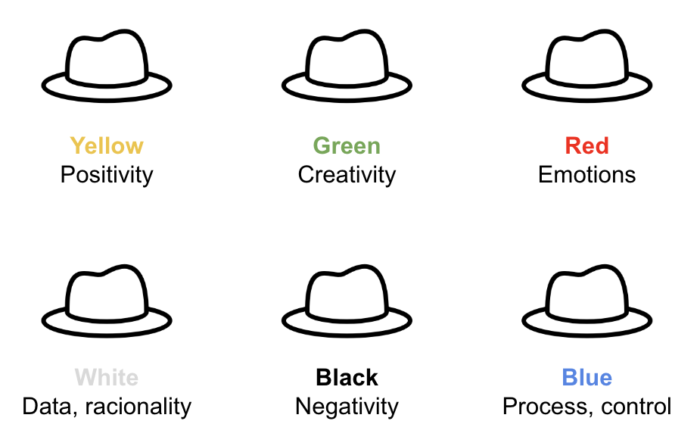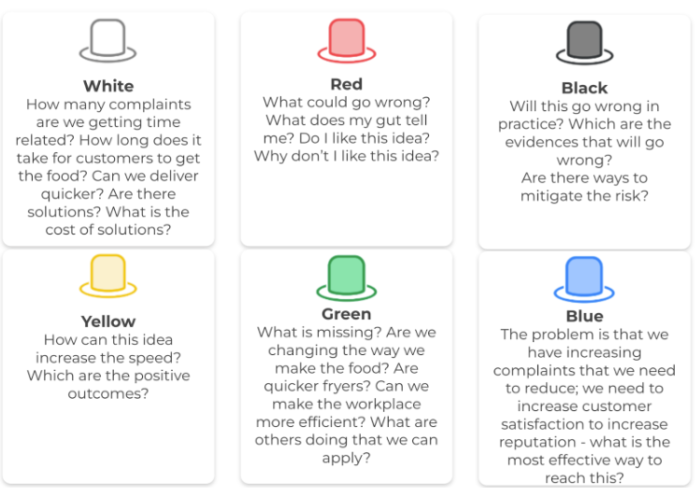Imagine that you are in the complex process of decision making and would like to know how to make this process easier and smoother. Do you know there are methodologies, frameworks, models, that can ease this?
The aim of this article is to show how the methodology of Six Thinking Hats can help you in decision making, as part of the business analysis process.
Business analysis is the practice of:
- determining problems and identifying the needs of a specific business.
- eliciting, documenting and managing stakeholder requirements aligned with business/project objectives.
- recommending solutions that deliver value to stakeholders.
- facilitating a successful implementation of the product/service.
The importance of business analysis is to guarantee an alignment between the business needs and the change solutions.
In order to do a good and more complete business analysis, it is important to look at a decision from different perspectives. This is where the Six Thinking Hats, developed by Edward De Bono, comes to the table.

“We may have a perfectly adequate way of doing something, but that does not mean there cannot be a better way. So we set out to find an alternative way. This is the basis of any improvement that is not fault correction or problem solving.” – Edward De Bono
This business analysis technique puts on the table the different perspectives on how to approach a discussion and is mostly effective when discussing in group, as each individual sees a subject with different eyes. This framework introduces parallel thinking as a more efficient way to approach discussions and solve problems where everyone is moving in the same direction, providing different inputs towards the same goal, instead of endless discussions that can generate conflict. Considering this, it is an amazing technique for group brainstorming activities.
However, it can also be approached individually if the analyst puts on all the hats and looks at the problem from different angles.
What are the Six Thinking Hats
The white hat, that relates to data/rationality basically consists of listing out all the facts, focusing on data and trends.
The red hat is about emotions/feelings focusing on gut and instinct and making the individual reflect on how he/she feels about the information received. This hat is the one that brings the emotional part to a rational process.
The black hat is the pessimistic one, where downsides and risks must be considered and all worst case scenarios must be taken into consideration.
The yellow hat is the opposite, and it is the optimist one, where benefits and opportunities are the focus.
The green hat represents creativity, where alternatives must be explored, and new ideas should be presented without censor.
The blue hat is the one for process/control, where one must never forget that in this process of decision making, the objective is the solution and must question if everything for the requirement has been considered and which are the next steps.
The Six Thinking Hats in practice
In group:
- A moderator wears the blue hat, understands the problem before the meeting and sets an agenda;
- Each team member (or group) wears a different of the other hats to bring different ideas to the table;
- It is important to break a large group into smaller ones and a good idea is to rotate the hats among team members in order to have different ideas/views or even have members wearing more than one hat at a time.
Individually/as a Business Analyst:
- It is helpful to wear some sort of template to section the notes;
- Must work each hat at a time and understand individually the different perspectives by making the correct answers:
- White hat: what do I know about the requirement? Is any information missing? Who should I talk to regarding this?…
- Red hat: how do I feel about what I was told/the requirements? Would I like this feature as a user?…
- Black hat: what are the downsides? Will the business lose something if we follow this approach?
- Yellow hat: will the business gain something from including this? Who will benefit?
- Green hat: are there alternatives to be considered? Can we do this in a different/better way?
- Blue hat: have we considered anything or are we missing steps? What is the next step?
- Taking the time, not jumping from one hat to the other, and making all the questions/notes for each hat is the key to success!
Practical example
A fast food chain is getting a growing number of complaints from customers that are waiting too long for their food – how can the company solve this problem?
Maybe a good option would be to substitute the fryers, which are old, and investing on new ones would lead to faster cooking.
Should they apply this? Here are some of the practical questions/thoughts:

The Six Thinking Hats technique, when done correctly, will help in the process of decision making, providing individuals (or groups) with all they need to make good decisions and solve problems. The method of switching between different ways of thinking can also bring to the table new perspectives, increasing the quality of decisions and coming up with the ultimate best solutions to the business.
Sources:
- Amran, Adam. (n.d). Six Thinking Hats.https://untools.co/six-thinking-hats
- Famuyide, Stephanie. (2014). The Six Thinking Hats Every Business Analyst Should Wear.https://www.businessanalystlearnings.com/blog/2014/10/6/the-six-thinking-hats-every-business-analyst-should-wear
- Nicholas, Jerry. (n.d). Introduction to the Six Thinking Hats | Foster Creative Discussions. https://businessanalystmentor.com/six-thinking-hats/
- Channel, Matthew. (2021). The Six Thinking Hats: How To Improve Decision Making, With Examples. https://www.tsw.co.uk/blog/leadership-and-management/six-thinking-hats/
- PMI – Global Standard (2017). The PMI Guide to Business Analysis. Project Management Institute, Inc.
- PMI – Global Standard (2015). Business Analysis for Practitioners – a practice guide. Project Management Institute, Inc.
